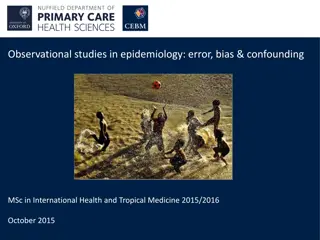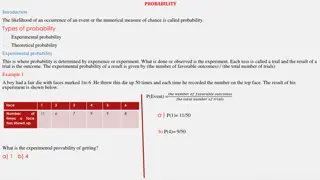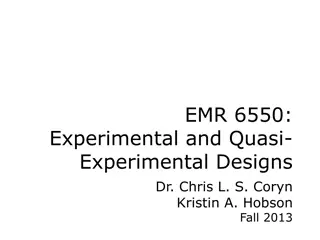Experimental Studies in Epidemiology
Epidemiological studies and experimental studies play vital roles in understanding cause-and-effect relationships in research. Experimental studies involve manipulating independent variables and measuring dependent variables, with categories such as true experimental, quasi-experimental, and pre-experimental designs. True experimental designs are characterized by control, randomization, and manipulation criteria. Different types of true experimental designs include pretest-posttest control group, posttest-only control group, and Solomon four group designs.
Download Presentation

Please find below an Image/Link to download the presentation.
The content on the website is provided AS IS for your information and personal use only. It may not be sold, licensed, or shared on other websites without obtaining consent from the author.If you encounter any issues during the download, it is possible that the publisher has removed the file from their server.
You are allowed to download the files provided on this website for personal or commercial use, subject to the condition that they are used lawfully. All files are the property of their respective owners.
The content on the website is provided AS IS for your information and personal use only. It may not be sold, licensed, or shared on other websites without obtaining consent from the author.
E N D
Presentation Transcript
Epidemiological studies Experimental Studies Nonexperimental Studies
Experimental study Experimental study is concerned with cause- and-effect relationships. All experimental studies involve manipulation of the independent variable (cause) and measurement of the dependent variable (effect).
Categories of experimental study The three broad categories of experimental study designs are: 1.True experimental, 2.Quasi-experimental, and 3. Pre-experimental.
True experimental designs True experimental designs are determined by three criteria: 1.Control (the researcher manipulates the experimental variable, at least one experimental and one comparison group or control group are included in the study), 2.Randomly (to either the experimental or comparison group). 3. Manipulation(independent variable is controlled by the researcher).
Types of True Experimental Designs Three types of true experimental designs are: 1.Pretest- posttest control group design, 2.Posttest-only control group design, and 3.Solomon four group design.
Types of True Experimental Designs the pretest- posttest control group design R O 1 X O2 (Experimental group) R O1 O2 (Comparison group)
Types of True Experimental Designs the posttest-only control group design R X O1 (Experimental group) R O1 (Comparison group)
Types of True Experimental Designs the Solomon four group design R O1 X O2 (Experimental group 1) R O1 O2 (Comparison group 1) R X O2 (Experimental group 2) R O2 (Comparison group 2)
Quasi-experimental designs Quasi-experimental designs have either no comparison groupor no random assignment of subjects to groups.
Quasi-experimental designs Nonequivalent control group design O1 X O2 (Experimental group) O1 O2 (Comparison group)
Types quasi-experimental designs Two quasi-experimental designs are: 1. Nonequivalent control group design and 2.Time-series design.
Types quasi-experimental designs the time-series design. O1 O2 O3 X O4 O5 O6
Pre-experimental designs: Pre-experimental designs are those in which the researcher has little control over the study.
Types of Pre experimental designs: Two types of pre-experimental designs are: One-shot case study X O One-group pretest-posttest O1 X O2
Extraneous variables that may influence study results in experimental studies. Extraneous variables, also called study limitations, confounding variables, and intervening variables, are uncontrolled variables that may influence study results.
these extraneous variables are called threats to internal and external validity. Internal validity concerns the degree to which changes in the dependent variable (effect) can be attributed to the independent variable (cause). External validity concerns the degree to which study results can be generalized to other people and settings.
Threats to internal validity Six threats to internal validity are : Selection bias, 2. History, 3. Maturation, 4. Testing, 5. Instrumentation change, and 6. Mortality. 1.
External Validity Three threats to external validity are : 1.Hawthorne effect, 2.Experimenter effect, and 3.Reactive effects of the pretest.
Nonexperimental Designs There are many different types of nonexperimental designs: Survey studies Correlational studies Comparative studies (retrospective and Prospective studies)
Types of Nonexperimental Designs Methodological studies(concerned with the development, testing, and evaluation of research instruments and methods). Secondary analysis studies Laboratory studies Field studies























